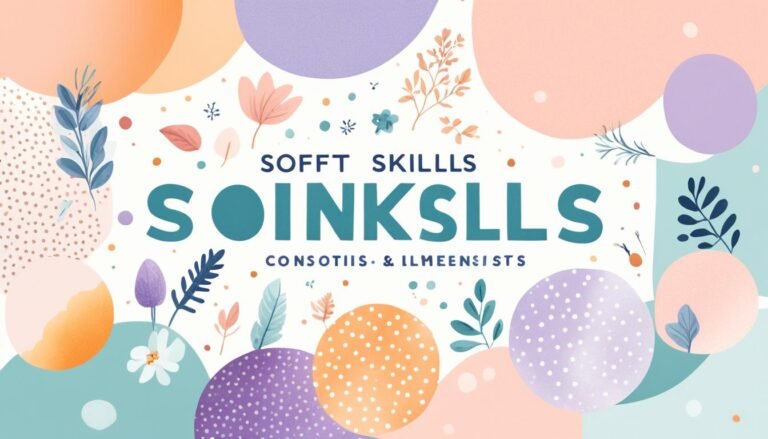Constructive Criticism as a Soft Skill
Embrace constructive criticism as a pivotal soft skill for growth and success. See feedback as a tool to enhance performance and skills. Use specific examples and positive framing for effective communication. Listen actively to tailor feedback for maximum impact. Constructive criticism fosters trust and strengthens relationships. Consider active listening, assertive communication, and non-verbal cues for feedback success. Overcome resistance by embracing feedback as a growth opportunity. Receive feedback graciously, ask questions, and express gratitude. Provide actionable, timely, and positive criticism for improvement. Cultivate a feedback culture for constant learning and advancement. Master constructive criticism for your professional journey.
Key Takeaways
- Constructive criticism enhances professional growth and performance.
- It provides specific examples for improvement.
- Framing feedback positively boosts receptiveness.
- Active listening tailors feedback effectively.
- Embrace feedback as a tool for continuous improvement.
Understanding Constructive Criticism
To effectively grasp the concept of constructive criticism, one must view it as a tool for growth and improvement in professional settings. Feedback techniques play an important role in this process, as they provide a structured approach to delivering and receiving feedback. Constructive communication is key to ensuring that criticism is delivered in a way that's helpful and empowering rather than discouraging.
When providing feedback, it's important to use specific examples to illustrate the areas that need improvement. This specificity helps the individual understand exactly what behaviors or actions require adjustment. Additionally, framing feedback in a positive light by highlighting strengths before addressing areas for development can make the criticism more well-received.
Active listening is another essential component of constructive criticism. Paying attention to the individual's responses and reactions can help tailor the feedback to be more effective. Encouraging a two-way dialogue fosters a sense of collaboration and mutual respect in the feedback process, ultimately leading to a more constructive and beneficial outcome.
Benefits of Constructive Feedback
Constructive feedback provides valuable insights that can drive professional growth and enhance performance. By receiving constructive feedback, you're presented with growth opportunities that allow you to identify areas for improvement and development. This feedback serves as a roadmap for enhancing your skills, knowledge, and overall performance in your professional endeavors.
One of the key benefits of constructive feedback is positive reinforcement. It not only highlights what you're doing well but also offers guidance on how to further excel in your role. This positive reinforcement can boost your confidence, motivation, and sense of achievement. Knowing that your efforts are recognized and appreciated can inspire you to continue striving for excellence.
Developing a Growth Mindset
To develop a growth mindset, you must embrace challenges as opportunities for personal growth.
Learning from mistakes is essential in fostering a mindset focused on improvement and progress.
Embracing Challenges for Growth
Once faced with challenges, you can choose to view them as opportunities for personal growth and advancement. Embracing challenges is a fundamental aspect of developing a growth mindset and fostering self-improvement.
When you confront difficulties head-on, you open yourself up to new experiences, learning opportunities, and the chance to expand your capabilities. By embracing challenges, you demonstrate resilience and a willingness to step out of your comfort zone, which are essential traits for personal development.
Instead of shying away from obstacles, see them as chances to enhance your skills, knowledge, and overall character. Embracing challenges not only propels you towards your goals but also shapes you into a more adaptable and determined individual committed to continuous growth.
Learning From Mistakes
Embracing mistakes is an essential element in developing a growth mindset. Viewing errors as learning opportunities is vital for personal and professional development. In cultivating a growth mindset, individuals acknowledge that setbacks are stepping stones to progress.
By reflecting on mistakes, you can identify areas for improvement and gain valuable insights into your strengths and weaknesses. Embracing a growth mindset fosters resilience and a willingness to take risks, ultimately leading to greater achievements.
Seeking Continuous Improvement
In your pursuit of continuous improvement, nurturing a growth mindset is pivotal for personal and professional development. Embracing a growth mindset involves actively seeking opportunities for self-reflection and learning from experiences.
By engaging in self-reflection, you can identify areas for improvement and set goals to enhance your skills and knowledge continuously. Moreover, active listening plays an essential role in this process. Actively listening to feedback provided by others allows you to gain valuable insights and perspectives that can help you grow.
Creating a feedback loop where you apply the feedback received to make positive changes fosters a culture of continuous improvement. Cultivating a growth mindset through self-reflection, active listening, and a feedback loop can lead to significant personal and professional growth.
Building Trust and Relationships
When aiming to build trust and relationships, remember that openness is key to fostering trust.
By showing empathy, you can create a deeper connection with others, leading to stronger relationships.
Effective communication plays an important role in building rapport and establishing trust in any interaction.
Trust Through Openness
To establish strong relationships and build trust, it's essential to cultivate openness and transparency in your interactions. Here are four key ways to foster trust through openness:
- Honest Communication: Be truthful and straightforward in your interactions to build rapport based on trust.
- Active Listening: Show genuine interest in others' perspectives, fostering connection through understanding.
- Sharing Vulnerabilities: Displaying vulnerability can create a safe space for others to do the same, strengthening trust.
- Consistent Behavior: Maintain consistency in your actions and words to build credibility and trust over time.
Empathy Fosters Connection
Empathy is a foundational element in nurturing genuine connections and fostering trust within relationships. By understanding and sharing the feelings of others, you create a strong bond that promotes growth and mutual respect.
Empathy allows you to see situations from different perspectives, enhancing your ability to communicate effectively and build meaningful connections. When you demonstrate empathy in your interactions, you show that you value the other person's emotions and experiences. This understanding leads to a deeper connection based on trust and respect.
As you cultivate empathy in your relationships, you pave the way for personal and professional growth, creating a positive environment where open communication and collaboration thrive.
Communication Builds Rapport
Communication plays a pivotal role in establishing rapport and cultivating trust in relationships. To effectively build connections through communication, consider the following:
- Active Listening: Engage fully with the speaker by focusing on their words, tone, and emotions.
- Nonverbal Cues: Pay attention to body language, facial expressions, and gestures to understand the underlying message.
- Open Communication: Encourage honest and transparent dialogue to foster trust and strengthen relationships.
- Empathy: Show understanding and compassion towards others' perspectives and feelings to create a supportive environment.
Effective Communication Strategies
Implementing effective communication strategies is essential for providing constructive feedback and fostering growth in a professional setting. Active listening plays a vital role in effective communication. When giving feedback, make sure to listen attentively to the other person's perspective. This shows respect and understanding, setting a positive tone for the conversation. Additionally, assertive communication is key. Clearly express your thoughts and feedback without being overly aggressive or passive. Being assertive helps make sure that your message is delivered clearly and that boundaries are respected.
Non-verbal cues are also important in communication. Maintain eye contact, use open body language, and nod to indicate that you're engaged in the conversation. These cues convey interest and attentiveness, making the feedback process more effective. Moreover, consider the timing of your feedback. Choose an appropriate moment when both parties are calm and receptive to guarantee that your message is received positively. By incorporating active listening, assertive communication, and non-verbal cues, you can enhance your communication strategies and provide constructive feedback more effectively.
Overcoming Resistance to Criticism
To overcome resistance to criticism, consider embracing constructive feedback as an opportunity for growth rather than a personal attack.
Cultivating a growth mindset allows you to view critique as a chance to improve and develop your skills further.
Embracing Constructive Feedback
Overcoming resistance to criticism requires a willingness to embrace constructive feedback as a valuable tool for personal and professional growth. Feedback acceptance is essential for self-improvement and enhancing performance.
To fully embrace constructive growth, consider these key points:
- Mindset Shift: View feedback as an opportunity to learn and develop rather than a personal attack.
- Active Listening: Engage attentively when receiving feedback to understand the perspectives shared.
- Action Plan: Use feedback to create a roadmap for improvement and set achievable goals.
- Continuous Improvement: Embrace feedback as a continuous process for refining skills and enhancing performance.
Cultivating Growth Mindset
Cultivate a growth mindset by reframing feedback as an opportunity for learning and development rather than criticism. Embracing a growth mindset allows you to see feedback as a valuable part of your journey towards improvement.
When you view feedback in this light, you open yourself up to a continuous feedback loop that propels your personal and professional growth. By actively seeking feedback and considering it as a means to enhance your skills and knowledge, you shift from a fixed mindset that resists criticism to a growth mindset that embraces constructive input.
Overcoming resistance to criticism becomes easier when you recognize feedback as a tool for advancement rather than a judgment of your abilities.
Receiving Feedback With Grace
Receiving feedback gracefully is an essential skill for personal and professional growth. When it comes to feedback etiquette, your ability to accept feedback with grace can have a major impact on your development. Here are four key points to keep in mind:
- Listen actively: When receiving feedback, concentrate on what's being said without interrupting. Take the time to understand the perspective being shared with you.
- Remain open-minded: Approach feedback with a willingness to learn and improve. Avoid becoming defensive or dismissive, as it can impede your progress.
- Ask clarifying questions: Seek clarification if you're unsure about any aspect of the feedback. This illustrates your interest in understanding and utilizing the feedback effectively.
- Express gratitude: Regardless of the nature of the feedback, show appreciation for the time and effort taken to provide it. A simple thank you can go a long way in fostering a positive feedback culture.
Providing Constructive Criticism
To provide effective constructive criticism, focus on delivering feedback that's specific and actionable, fostering growth and improvement in the recipient.
When giving feedback, make sure that it's timely and relevant to the situation at hand. Start with positive critique to establish a supportive tone and then address areas for improvement.
Be clear and concise in your feedback delivery, avoiding vague statements that may confuse the recipient. Provide examples to illustrate your points and offer suggestions for how the individual can enhance their performance.
Remember to focus on the behavior or outcome that needs improvement rather than criticizing the person themselves. Encourage an open dialogue where the recipient can ask questions or seek clarification.
Creating a Feedback Culture
Fostering a culture of continuous feedback within an organization is essential for promoting growth and development among team members. Here are four key strategies to help create a feedback culture that enhances team dynamics and improves the overall workplace environment:
- Encourage Open Communication: Establish an environment where team members feel comfortable sharing their thoughts and ideas without fear of judgment. Encourage constructive dialogue by actively listening to different perspectives.
- Provide Regular Feedback: Schedule regular feedback sessions to discuss progress, address concerns, and provide constructive criticism. Consistent feedback helps team members understand their strengths and areas for improvement.
- Lead by Example: Demonstrate the importance of feedback by actively seeking input from your team and being open to receiving feedback yourself. Show that feedback is a two-way street that benefits everyone.
- Celebrate Growth: Acknowledge and celebrate improvements made based on feedback. Recognizing progress encourages a culture of continuous learning and development within the team.
Continuous Improvement Through Critique
Encouraging continuous improvement through constructive critique can greatly enhance team performance and foster a culture of excellence within an organization. Receiving feedback is an important aspect of this process. By actively seeking feedback from peers and supervisors, you demonstrate self-awareness and a commitment to growth. Embracing a growth mindset enables you to view critique as an opportunity for learning and improvement rather than a personal attack.
To facilitate continuous improvement effectively, consider the following strategies:
| Strategies for Continuous Improvement | Description | Benefits |
|---|---|---|
| Actively seek feedback | Request input from colleagues on your performance | Gain insights for self-improvement |
| Reflect on feedback received | Analyze critiques to identify areas for growth | Enhance self-awareness and development |
| Set specific improvement goals | Establish clear objectives based on feedback | Track progress and measure success |
| Implement feedback consistently | Integrate feedback into your routine practices | Enhance performance and skill development |
Conclusion
To sum up, embracing constructive criticism as a soft skill is essential for personal and professional growth.
By understanding its benefits, developing a growth mindset, and mastering effective communication strategies, you can build trust, improve relationships, and foster a culture of continuous improvement.
Remember, receiving feedback with grace and providing constructive criticism are key components in this process.
Embrace the power of critique to propel yourself towards success.








